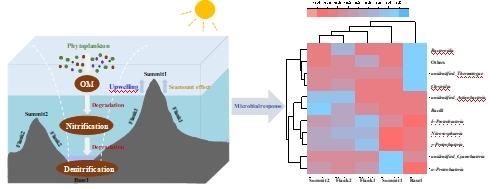Seamounts are defined as isolated terrain elevations with a depth of more than 1000 meters above the seafloor. The presence of seamounts affects the circulation of seawater, inducing nutrients upwelling mobility and stimulating primary production, thereby producing organic matters (OMs).
The Tropical Western Pacific Ocean (TWPO) belongs to oligotrophic regions, while seamounts increased surrounding chlorophyll content and primary productivity levels.
However, there are few studies on the distribution and degradation pattern of organic matter in seamounts morphology by using microorganisms and nutrients as indicators.
Recently, Dr. LAI Xiaoshuang of the research team led by Prof. SONG Jinming at Institute of Oceanology, Chinese Academy of Sciences (IOCAS), discovered differences in OM degradation of M5 Pair-summit Seamount morphology in the Tropical Western Pacific Ocean.
The study was published in Ecological Indicators on Feb. 5.
To further grasp the distribution of seamounts OM and the composition of related microorganisms, researchers employed high-throughput sequencing technology to analyze the particulate matters. The dynamic distribution of nutrients, particulates and microbial communities of the summits, flanks and base in the M5 Pair-summit Seamount were investigated.
Researchers found the distribution of OM in seamounts presented a gradual decrease from summit to base. At Summit1 (depth of 106 m), Cyanobacteria dominated (18.06%), total organic carbon (TOC) obtained the highest value of 1.23 mg L-1, and OM was produced through phytoplankton photosynthesis.
On the Summit2 (depth of 810 m) and flanks, the degradation of OM occurred, Taumarchaeota with a higher proportion (Summit2 = 6.35%, Flank1 = 8.22%, Flank2 = 8.84%), which corresponded to the process of nitrification.
The distinction between summits of OM distribution lies in the "seamount effect" generated by shallow seamounts. At the base of the seamount, the degradation reached the highest, and Firmicutes accounted for 38.86%.
"It indicated that the degradation of OM in seamount base lead by denitrification and utilized as a carbon source by denitrifying bacteria," said Prof. SONG. In short, seamounts morphology and the surrounding hydrological environment result in significant differences in the distribution and degradation of OM and microbial community composition of seamounts.
"Using microorganisms and nutrients as indicators provides a new way to study the degradation of OM in seamounts," said Prof. SONG.
This study was supported by the Major Program of the Pilot National Laboratory for Marine Science and Technology (Qingdao), National Natural Science Foundation of China, the Strategic Priority Research Program of the Chinese Academy of Sciences, and Natural Science Foundation of Shandong Province. This work was also thanks to the crews in "Science" Survey Vessel for their support in data collection and help in the cruise.

Schematic diagram of organic matter degradation formation mechanism of M5 Pair-summit Seamount in the Tropical Western Pacific Ocean
Xiaoshuang Lai, Xuegang Li*, Jinming Song*, Jun Ma, Huamao Yuan, Liqin Duan, Ning Li, Ziyang Yang. (2022). Biogeochemical characteristics and microbial response to indicate degradation of organic matter around Pair-summit Seamounts in the Tropical Western Pacific Ocean. Ecological Indicators, 136, 108637.
LI Xuegang
Institute of Oceanology
E-mail: lixuegang@qdio.ac.cn
(Editor: ZHANG Yiyi)
|
|

Address: 7 Nanhai Road, Qingdao, Shandong 266071, China
Tel: 86-532-82898902 Fax: 86-532-82898612 E-mail: iocas@qdio.ac.cn


